Continued from Jay Epae’s epic career, 1: from Manaia to Sweden
--
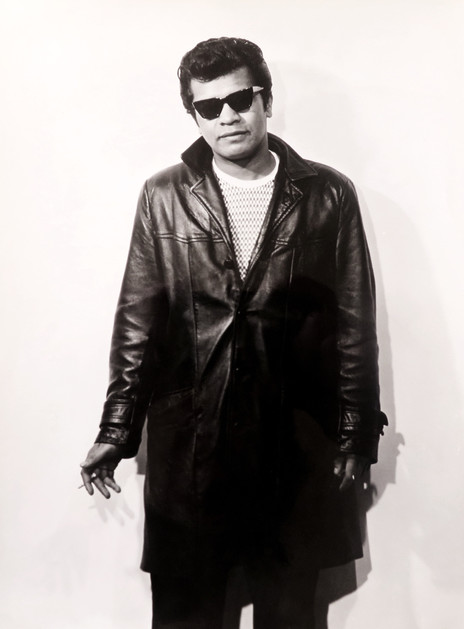
Jay Epae in 1966.
In 1962 Jay Epae’s brother Wes was touring Sweden with The Māori Hi-Five. The group was booked to appear at an outdoor summer festival, he recalls. “When we arrived, there was just a single-lane track to get in and out of the venue, as we crawled along at about 5km an hour, we could hear people singing ‘Putti Putti’ in the distance. As we got closer we were encountered by dozens of young people setting up their tents and all singing it in unison. We knew that the song was big there but this really brought it home for us.”
Jay’s hit ‘Putti Putti’ also reached No.1 in Finland although a certain amount of sales were lost to a stilted local cover version by Kai Lind which peaked at No.4. A Scandinavian trifecta was averted when it only reached No.2 in Denmark. In total ‘Putti Putti’ was released in seven countries: The United States, Sweden, United Kingdom, Finland, Denmark, Germany, and Norway.
‘Putti Putti’ was not released in New Zealand at the time even though Mercury Records had a high profile locally. It wasn’t officially released in New Zealand until 2011 when it was compiled on the EMI various artist compilation CD Waiata which was a collection of Māori showbands and singers.
Not only is ‘Putti Putti’, New Zealand’s first international No.1 record, it is also one of the most covered New Zealand songs with nearly 30 known cover versions in various styles and languages; try as they might none of them come close to matching Jay’s lively vocals and feeling:

Jay Epae - pictures sleeves of interpretations of Putti Putti from around the globe. From left Kukonpojat (Finland, 1961), Otto Brandenburg (Denmark, 1961), The Māori Hi-Five (Aotearoa, 1963; Wes Epae on lead vocals), and Kai Lindd (Finland, 1961). Others who covered the song include: Neloset (1961), Kukonpojat (1961), Sten Nilsson (1969), The Spotniks (1970), Rohdes Rockers (1973), Dick Dynamite And His Hot Lips (1974), Leif Hultgens (1974), Nordre Sving (1975), Max Fenders (1975), Martys (1976), Sten & Stanley (1976), Trastinis (1977), Urpo (1978), Grus I dojjan (1978), Brogen’ me Teddyboys (1979), Ostgotarna (1979), Johan Stengard (1985), Bertj Idoffs (1986), Burken and Rockfolket (1989), Lea Laven (1990), Tonix (1990), The Buckaroos (1997), Ivo Linna ja Rock Hotel (1999), and The Accordian Boogiez (2020).
At first glance it appears an anomaly that ‘Putti Putti’ could be such a big record in Scandinavia, but the Swedes were no novices when it came to Hawaiian-styled music. Yngve Stor’s Hawaiian Orchestra was a popular Swedish band specialising in Hawaiian-styled music in a career that spanned from the mid-1930s to the 1970s and beyond.
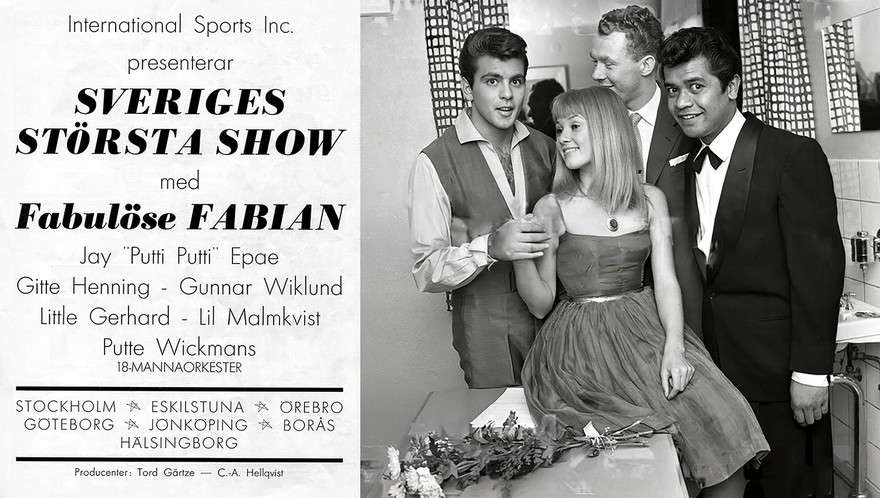
Jay Epae (right) during a Swedish tour with, among others, US teen idol Fabian (left), who is holding the hand of Danish teenage singer Gitte Henning
Starting on the 14th of October Jay toured Scandinavia with American teen idol Fabian, leading European female singer Gitte Henning, and Little Gerhard who was labelled “The Nordic King of Rock ‘n’ Roll”. Fabian said, “The thing that I remember about that tour was the girls screaming at me and singing along with Jay.”
Jay’s follow up single ‘Hula-Cha’ b/w ‘It’s Drivin’ Me Wild’ was released to coincide with the tour and peaked at No.16 on the Swedish charts. ‘Hula-Cha’ was written by Jay with Sylvia McKinney, a pseudonym for Joe Senaca. Two of Senaca’s compositions were in the charts at the time, Brenda Lee’s ‘Break It To Me Gently’, and Ike and Tina Turner’s R&B classic ‘It’s Gonna Work Out Fine’.
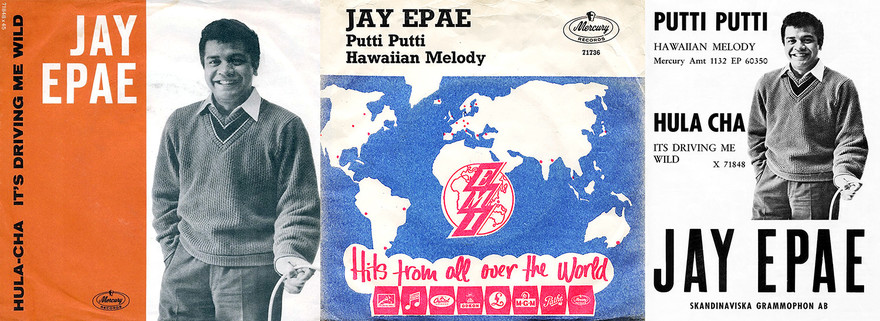
Jay Epae: Hula Cha (Denmark, 1961), Putti Putti / Hawaiian Melody (Denmark, 1961), and a Swedish advertisement
A few weeks after its US release, Conway Twitty released his version of ‘It’s Drivin’ Me Wild’, which he tended to over-sing on and it fell well short of Jay’s rockier and warmer vocals and production. During the Scandinavian tour Jay pretended on occasions not to be able to speak English, which usually necessitated fans, especially the females, trying to teach him a few basic English words, while Jay presumably struggled to keep a straight face. Such was Jay’s profile in Sweden that he was immortalised in a set of Star C Bilder gum trading cards, alongside movie stars and pop singers of the time, including Elvis Presley, James Dean, Rock Hudson, and Elizabeth Taylor.
After the tour with Fabian, Jay stayed in Sweden for another three months. As 1961 came to an end it was announced that he was the third biggest selling artist in Sweden behind Elvis Presley and local singer Little Gerhard, with whom he had just toured.
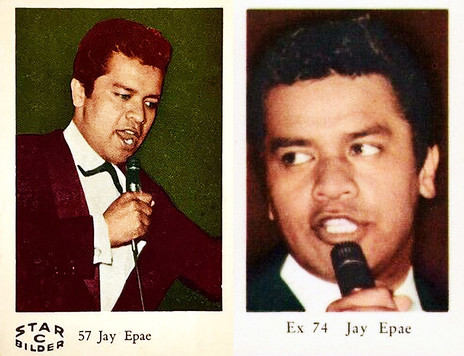
Jay Epae on Swedish gum trading cards no.57 and no.74 from 1962
The Swedish press were puzzled by Jay being “American” but no one in America knew of him. This changed slightly when Jay returned to New York after his Swedish tour and appeared on television in The Steve Allen Show and The Dick Clark Show, both of which were broadcast from New York. It was during this period that Jay appeared alongside two of the biggest acts of the time, The Drifters and Paul Anka.
Jay recorded two more singles for Mercury, ‘Dance With Me Lulu’ b/w ‘Wassa Matta You’ in early 1962. ‘Wassa Matta You’ featured top session musician Everett Barksdale who had played and was responsible for the guitar on Mickey & Sylvia’s classic ‘Love Is Strange’. Towards the end of 1962 Jay’s composition ‘Your Tender Touch’ was released as a single by the artist ‘Demetrius’. Jay recorded his version as his last Viking single in mid 1967.
Clyde Otis left Mercury and in 1962 started up his own production company, Argon Productions, which was mainly released through Capitol Records. Jay’s Mercury contract was about to expire and Clyde made Jay one of his first signings. A year after his last Mercury single Jay released ‘My Girl’ b/w ‘Coffee Grind’, released on Capitol Records in April 1963. Jay wrote both sides with George Butcher who also produced the tracks. (Butcher would go on to produce Country Joe and The Fish in 1967.)
Four months later, in late August, Jay released his last American single, ‘Surfin’ On Waikiki’ b/w ‘Patu, Patu’, produced by Belford Hendricks. Cashbox review of the single said “Jay Epae could get back in the money-making groove once again with this rousing, self penned, chorus-backed surfin’ item. The side boasts some effective grunts and top-flight lyrics.”
During this period Jay was working the New York and wider East Coast area with his troupe, billed as “Jay Epae (Capitol Records Star) & His Waikiki Island Revue”. The revue consisted of Jay and three hula dancers, led by “Ula” (of Pago-Pago and Scottish descent). According to the local press, her looks were so stunning that she was invited by MGM to audition for them. She left the troupe shortly after, never to be heard from again.
With no record contract during 1964, Jay continued his club act and wrote and produced several songs for other artists, including both sides of a one-off single by ‘The Oddballs’ called ‘Jesse James’ b/w ‘Suzy’. Jay co-wrote the song with experienced songwriter John Leslie McFarland, whose Mort Shuman co-written song, ‘Little Children’ was in the charts at the time for Billy J Kramer and The Dakotas. McFarland started his career writing for Louis Jordan, Bill Haley and The Comets and Aretha Franklin in the 1950s and early ’60s, before writing or co-writing two of the early ‘60s biggest hits, Elvis Presley’s ‘Stuck On You’ and Johnny Burnette’s ‘Dreamin’. The other co-writer was Joe Castaldo aka Joey Castle who was one of the best Elvis impersonators at the time. It is his distinctive voice that can be heard as the lead vocalist, with Jay on backing vocals.
By 1965 Jay and Leona’s marriage had irreparably broken down, with Leona citing Jay’s infidelities as the main problem. He returned to New Zealand in early 1966 a broken man, masking the sadness of his marriage break-up with alcohol. Jay left behind a pile of unpublished songs and several unreleased tracks, including the tantalisingly named ‘Pineapple Twist’ and ‘Twist Lulu Twist’. Little is known of Jay’s movements during 1965 before he returned to New Zealand in early 1966. There are unsubstantiated reports that he spent time in Sweden, Hawaii, and possibly Sydney.
According to Ron Dalton of Viking Records, Jay knocked on his office door in Auckland and introduced himself. Dalton, a self-confessed Americanophile, was fully aware of Jay and had no hesitation in signing him as a writer and artist.
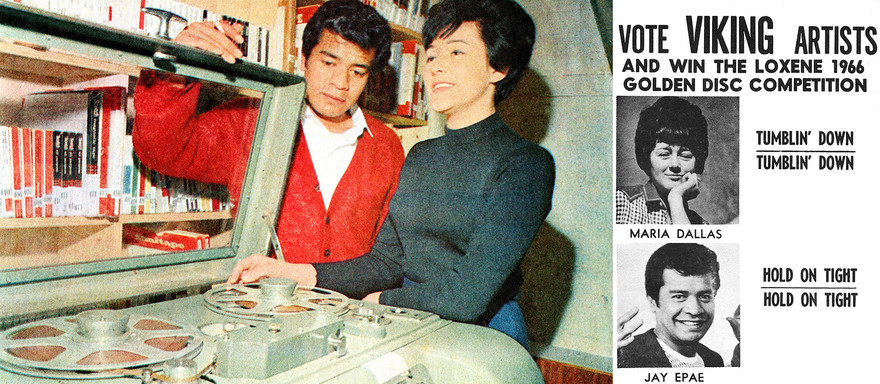
Jay Epae and Maria Dallas listening to Tumblin' Down, and a Viking ad in anticipation of the 1966 Loxene Golden Disc competition
Dalton signed Maria Dallas at approximately the same time as Jay and, even at this early stage of her career, had high hopes of breaking her into the US market. With Jay and his experience on board, possible opportunities were falling into place. Work was already under way on Dallas’s debut album and single. With a handful of cover versions already recorded, Ron asked Jay if he had anything suitable for her in a pop/country vein.
Jay’s sister Tui recalls: “Jay was visiting us, not long after he returned to New Zealand. My son Lester was at the age when he was trying to walk. Jay took great delight watching him trying to climb up chair legs and the coffee table to steady himself, but he kept falling and trying again. ‘He keeps tumbling down,’ Jay was proclaiming.
“I was in the kitchen when Jay shouted out to me, ‘Tui, Tui, quick grab me a pen and paper!’ What do you need a pen and paper for? ‘I’ve got a song idea,’ he replied as he watched Lester repeatedly come tumblin’ down.”
Watching Lester was the catalyst for Jay to pour out his feelings into a song of lost love and longing for all to hear after his breakup with Leona. Maria Dallas’s effervescent vocal style and the song’s poppy production masked Jay’s sadness:
Got a troubled mind and I’m feelin’ sad
I’ve lost the only love I’ve ever had
Since he’s gone and left this town
My love came tumblin’ down
Oh yes a tumblin’ a tumblin’ tumblin’ down ...
Tumblin’ tumblin’ tumblin’ down
Tumblin’ a tumblin’ tumblin’ down
My love came tumblin’ down
Days are long and nights are lonely
I’ve lost my love, my one and only
Like autumn leaves falling on the ground
My love came tumblin’ down
Oh yes a tumblin’ a tumblin’ tumblin’ down ...
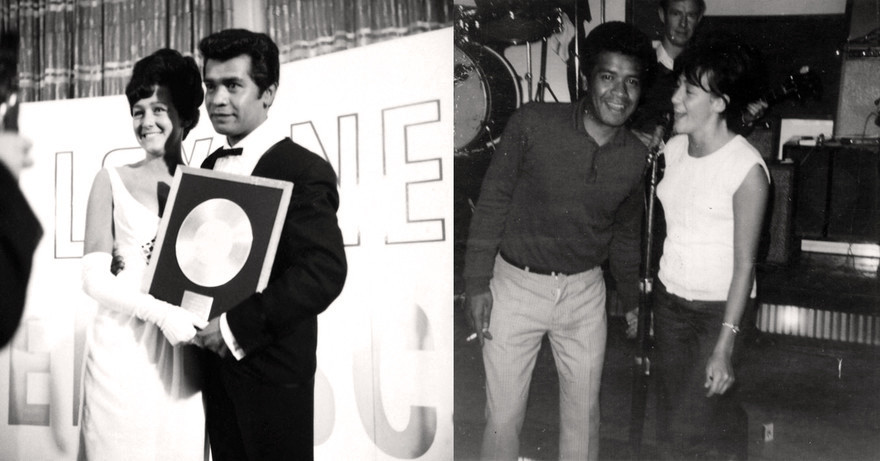
Jay Epae and Maria Dallas with the Loxene Golden Disc she won for his song Tumblin' Down, 1966
The song was recorded and released in time to meet the deadline criteria for entry into the Loxene Golden Disc award. ‘Tumblin Down’ became an overnight hit and propelled Dallas from an unknown to the name on everybody’s lips by the time it debuted on the New Zealand Hit Parade on 25 August 1966. The song peaked at No.4 and also made the finals of the Loxene Golden Disc award alongside Jay’s single ‘Hold On Tight’.
‘Tumblin’ Down’ won the coveted 1966 Loxene Golden Disc Award for the best New Zealand record – as voted by the public – and must have come close to winning the Apra Silver Scroll award for Jay. Ray Columbus won the Scroll with his composition ‘I Need You’, which was his debut solo single.
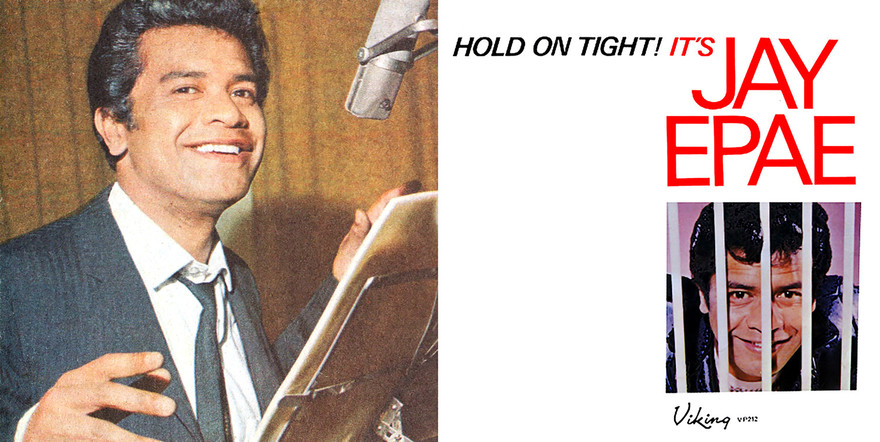
Jay Epae in the NZ Women's Weekly, 1966; and the cover of his only album, Hold On Tight (Viking, 1966)
Shortly afterwards, Jay’s album Hold On Tight! It’s Jay Epae was released on Viking; it featured seven of Jay’s compositions. The inclusion of three of Clarence Frogman Henry’s hits, ‘But I Do’, ‘You Always Hurt The One You Love’ and ‘Just My Baby And Me’ – along with ‘Red Sails In the Sunset’ as popularised by Fats Domino – gave the album a distinct New Orleans flavour and were perfect companions to Jay’s eclectic mix of original compositions. His own songs were in varying styles, from the beaty ‘15 Girl Friends’, the Pacifica styling of ‘Under The Palm Trees’, the Elvis-inspired rocker ‘What Can I Do’, plus Jay’s version of ‘Tumblin’ Down’. The album also included both sides of his debut Viking single ‘Hold On Tight’ and ‘The Creep’. On Jay’s songs ‘I’ll Cry Tomorrow’ and ‘What Can I Do’, he hints that his marriage infidelities may not have been one-sided.
‘The Creep’ was released in Germany in December 1966 where Jay found himself in direct competition with Tony Sheridan’s version. Tony Sheridan was an English singer, resident in Germany, and best known for his recordings with The Beatles during their Hamburg period, including the single ‘My Bonnie’. Tony’s version of ‘The Creep’ was released in New Zealand four months later, while Jay’s version was released in Sweden, Germany, France, Norway, Yugoslavia and Australia.

Jay Epae - The Creep. Picture sleeves from Germany, Italy and the Netherlands
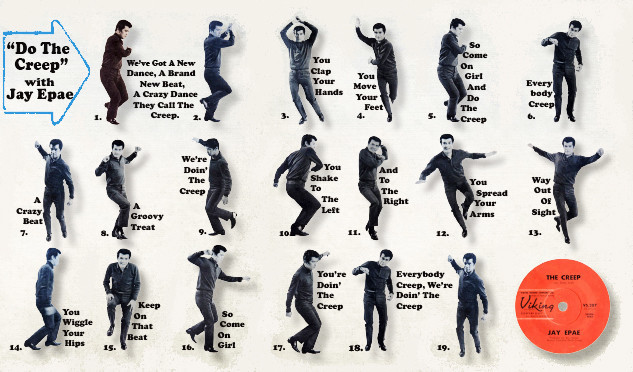
Jay Epae demonstrates how to do The Creep
Jay rode a wave of popularity for six months, with double-page spreads in the New Zealand Woman’s Weekly and the December edition of Teen Beat magazine. The latter included a centre spread of step-by-step instructions to dance the Creep. Jay started 1967 off by appearing on the Chris Bourn-produced TV programme Golden Girl which was a showcase for Maria Dallas’s recent popularity and success, in which Jay played a big part. On the show Jay and Maria duetted on ‘Tumblin’ Down’.
Jay toured New Zealand as part of the Maria Dallas Show during late 1967. Also on the tour was country singer Ken Lemon, who recalls one of his core non-performing duties: “Jay had a drinking problem, he would sleep it off after the previous night and it was my duty to wake him at five o’clock in the afternoon and make sure that he was fed, showered, dressed and backstage ready to perform by seven, but once he was on stage he was the ultimate professional entertainer.”
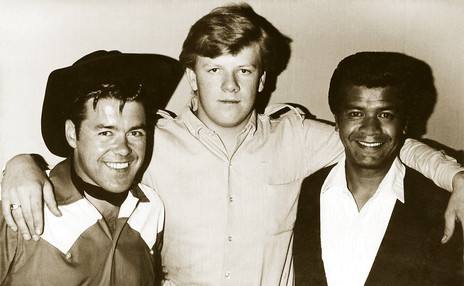
Ken Lemon (left), road manager Jim Pilcher and Jay Epae during the Maria Dallas Country Show tour in 1967. - Jim Pilcher Collection
Paul Walden, another singer on the bill, remembered, “I was touring with The Quin Tikis, Howard Morrison and John Hore [Grenell] on one of Joe Brown’s Miss New Zealand tours, and managed to catch Jay’s act on a rare night off. You could tell that he had a lot of overseas experience, he was like a one-man version of our whole show. He did jokes, impersonations, handled the ballads with aplomb and did the pop and country songs with class. I was a regular visitor to the Epae household in my youth, Wes and I started our musical careers as a duo in Wellington in the late-50s, but this was the first time that I had really seen Jay.”
In mid 1967, Maria Dallas returned home from Nashville, having re-recorded ‘Tumblin’ Down’ with Elvis Presley’s then-producer Felton Jarvis (this version was subsequently released in the US on RCA).
After the release of his next single ‘Your Tender Touch’ b/w ‘You’ve Got What It Takes’ – and a gig at Napier’s Centennial Hall with The La De Da’s and The Fourmyula – Jay announced that he was going to Sydney for several bookings. He said he would be back in two to four weeks.
The two weeks turned into two decades. He turned up in Sydney without any chart arrangements, which rendered him unemployable by the powerful Australian Musicians’ Union. Times had changed in Sydney since the mid-50s when Jay last worked there. Desperate to keep working, he approached fellow New Zealander, musical director Bernie Allen, to write a set of charts for him.
After appearing on Australian TV in 1968, Jay relocated the Gold Coast until the early 1990s
Jay spent a few years in Sydney and appeared on the 28 July 1968 episode of Brian Henderson’s TV pop show Bandstand, along with Sandy Edmonds. He then relocated to the Gold Coast. There is little evidence of Jay’s several decades in Queensland. Maria Dallas, who was extensively working in the area during the same time, only ever remembered running into Jay once; fellow New Zealand musician and promoter in the area Maurice (Mo) Mersky recalls being let down by Jay on several occasions before he and others had no other option than to treat him with caution as his drinking problem spiralled out of control.
Substance abuse problems plagued Jay for the remainder of his life. This took the momentum out of his career. He was certainly a talent and had a lot more to offer the music world.
Tui Epae: “I received a phone call from Jay’s landlady Mary, in Brisbane. She was concerned about his health and well-being, so she entered his room and found my name and managed to track me down. I arranged for [brother] Roy to find him and bring him home where we could look after him. Roy eventually found him drinking under a bridge with the local Aborigines. He was in such poor health that he arrived back home in a wheelchair.
“We intended to send him back home to Manaia, but Jay refused, so he ended up staying with me in Wellington. As a family we tried to clean him up but it was always one step forward and two steps back for him. On occasions he would disappear for a day or two, on the lookout for booze or whatever he could get his hands on, and he would eventually turn up as if nothing had happened”.
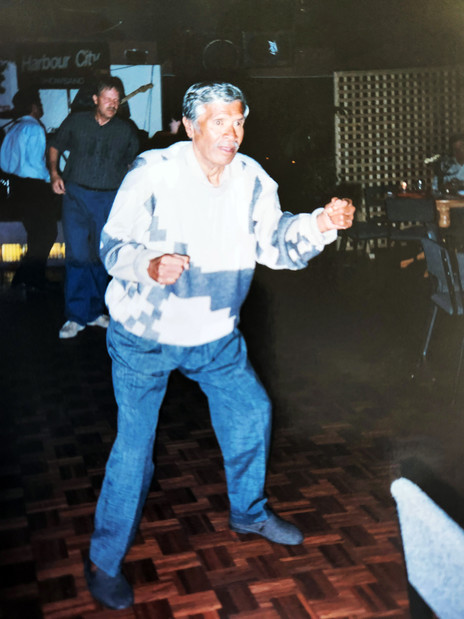
Jay Epae at Wellington cabaret The Pines doing "the creep" for the last time, early 1990s. - Epae Family Collection
An enduring memory for the Epae family occurred one night when Tui, Dawson, Jay and Tui’s daughter Debbie all went to The Pines. After dinner and as the music began, Jay got up and danced ‘The Creep’ – for the last time. A recent approach by a Swedish TV producer to do a show on Jay was an incentive for Jay to start performing again. Unfortunately Jay was living on borrowed time and on 8 September 1994 he was found dead on a Wellington street, aged 61. It was only three months after he arrived back home in New Zealand.
--
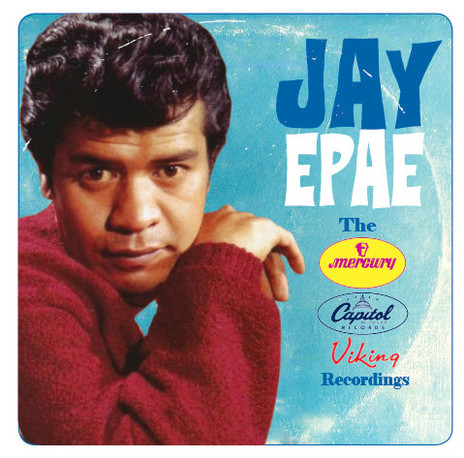
The Jay Epae Collection (Frenzy, 2025), compiled by Grant Gillanders, features 33 tracks by Jay Epae while he was on the Mercury, Capitol, and Viking labels